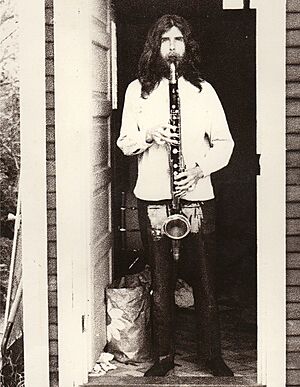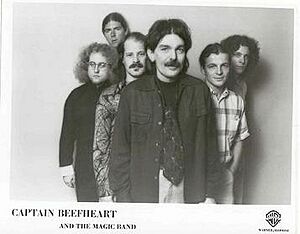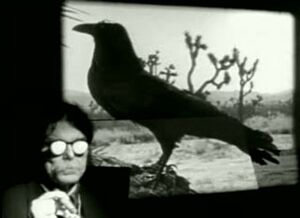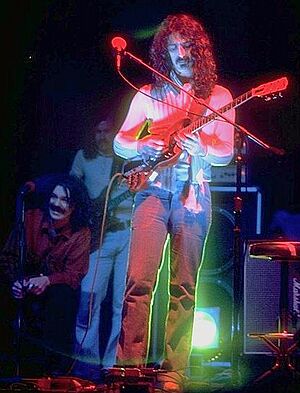Captain Beefheart facts for kids
Quick facts for kids
Captain Beefheart
|
|
|---|---|
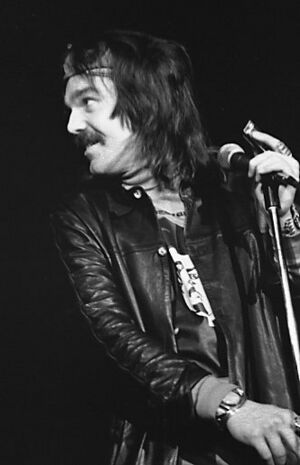
Beefheart performing at Convocation Hall in 1974
|
|
| Background information | |
| Birth name | Don Glen Vliet |
| Also known as |
|
| Born | January 15, 1941 Glendale, California, U.S. |
| Died | December 17, 2010 (aged 69) Arcata, California, U.S. |
| Genres |
|
| Occupation(s) |
|
| Instruments | |
| Years active | 1964–1982 |
| Labels | |
Don Van Vliet (born Don Glen Vliet; January 15, 1941 – December 17, 2010) was an American artist and musician. He was best known by his stage name, Captain Beefheart. With his band, The Magic Band, he recorded 13 studio albums between 1967 and 1982.
His music mixed different styles like blues, jazz, and rock. It also had unusual rhythms and a deep, gravelly voice. Captain Beefheart was known for his mysterious personality. He often made up stories about his life. He also had strong control over the musicians in his band.
Even though he wasn't very famous, many experimental rock and punk artists looked up to him. After stopping music in 1982, he became a successful painter. His abstract paintings are now shown in galleries around the world. Van Vliet passed away in 2010 after living with multiple sclerosis for many years.
Contents
- Who Was Captain Beefheart?
- Friendship with Frank Zappa
- The Magic Band
- Music Style
- Legacy and Influence
- Discography
- Images for kids
- See also
Who Was Captain Beefheart?
Early Life and Creative Beginnings (1941–1962)
Don Glen Vliet was born in Glendale, California, on January 15, 1941. His father was a service station owner, and his mother was from Arkansas. Don started painting and sculpting when he was only three years old. He loved animals, especially dinosaurs and fish.
People thought he was a child genius. At age four, his animal sculptures were shown on a TV show in Los Angeles. When he was nine, he won a sculpting contest at the Los Angeles Zoo. He even worked as an apprentice for a local art tutor.
Don's parents didn't always support his art. They turned down a scholarship for him to study sculpture in Europe. This made him very sad. He later said this experience made him stop art for a while.
When he was 13, his family moved to Lancaster, California, in the Mojave Desert. This new environment greatly influenced his art and music. He continued to paint, and some of his paintings were used as album covers.
He also started listening to a lot of music. He loved Delta blues artists like Son House and Robert Johnson. He also enjoyed jazz musicians such as Ornette Coleman and John Coltrane.
During his teenage years, Don met Frank Zappa, who would become a lifelong friend and collaborator. They bonded over their love for Chicago blues and R&B. Don even recorded his first song, "Lost in a Whirlpool," with Zappa.
Don often said he didn't go to public school. However, he did attend Antelope Valley High School. He may have dropped out to help his family after his father had a heart attack. He also had dyslexia, which made reading difficult for him.
The name "Captain Beefheart" came from Frank Zappa. Don later said it meant "a beef in my heart against this society." Before music, he worked as a vacuum cleaner salesman. He even sold one to famous writer Aldous Huxley.
Starting the Music Journey (1962–1969)
In 1965, a guitarist named Alex Snouffer asked Don Vliet to sing in his new band. Don joined and changed his name to Don Van Vliet. Snouffer became Alex St. Clair. This was the start of The Magic Band.
Captain Beefheart and his Magic Band signed with A&M Records and released two singles in 1966. One was a cover of Bo Diddley's "Diddy Wah Diddy," which became popular in Los Angeles.
Safe as Milk Album
The band then started working on their first album, Safe as Milk. A&M Records thought their new music was "too negative" and dropped them. But the band soon signed with Buddah Records.
John French joined as the drummer. He would later help turn Van Vliet's musical ideas into actual songs. Many of the album's lyrics were written by Van Vliet and his friend Herb Bermann.
The album was released in September 1967. It mixed blues-rock with unusual rhythms and Van Vliet's unique vocals. Even John Lennon of The Beatles liked the album.
Challenges and New Sounds
After Safe as Milk, the band faced some problems. Guitarist Ry Cooder left, and Van Vliet had severe anxiety attacks. At one festival, he walked off stage, claiming he saw a girl turn into a fish. This led to them missing a big performance at the Monterey Pop Festival.
In 1967, Jeff Cotton joined as guitarist. The band recorded material for a second album. But their record label, Buddah, rejected it. Instead, some songs were re-recorded and released as Strictly Personal in October 1968. This album had a "phasing" effect added by the producer, which many felt hurt the music.
Some of the earlier recordings were later released in 1971 as Mirror Man. This album was more like a long jam of blues-rock.
Trout Mask Replica (1969)
Trout Mask Replica was released in June 1969 on Frank Zappa's new label, Straight Records. It was a double album with 28 songs. Many critics consider it Van Vliet's greatest work.
For this album, Van Vliet gave his band members new nicknames. Bill Harkleroad became Zoot Horn Rollo, Mark Boston became Rockette Morton, and John French was Drumbo. His cousin, Victor Hayden, was the Mascara Snake.
Van Vliet wanted the band to "live" the album. They rehearsed his difficult songs for eight months. They lived together in a small rented house in Los Angeles. Van Vliet was very strict with his musicians. He would yell at them for days until they gave in.
The band members had very little money and often went hungry. They practiced for 14 or more hours a day. John French later wrote about the tough conditions, including physical abuse. After the album was recorded, Van Vliet kicked French out of the band.
Van Vliet said he wrote all 28 songs in one 8.5-hour session at the piano. However, band members said the songs were developed over about a year. The band practiced so much that they recorded the music for 21 songs in just four and a half hours. Van Vliet then added his vocals.
The album cover shows Beefheart wearing a fish head as a mask. This image was photographed by Cal Schenkel. Trout Mask Replica mixed blues, experimental music, and rock. It had complex rhythms, slide guitar, and unique saxophone sounds. Van Vliet's vocals ranged from deep growls to high-pitched singing.
Frank Zappa produced the album. He let Van Vliet do whatever he wanted, even if it seemed strange. Van Vliet also spread myths about himself, like claiming he taught his guitarists to play from scratch.
Critics praised Trout Mask Replica for its unique sound. BBC disc jockey John Peel called it "a work of art." It has influenced many artists in punk and new wave music. In 2003, Rolling Stone magazine ranked it among the 500 greatest albums of all time.
Later Music and Retirement (1970–1982)
Lick My Decals Off, Baby
In 1970, Captain Beefheart released Lick My Decals Off, Baby. This album was also very experimental. It was his most successful album in the United Kingdom, staying on the charts for 20 weeks. A strange music video was made for the title song. It showed masked band members using kitchen tools as instruments.
The Spotlight Kid and Clear Spot
The next two albums, The Spotlight Kid (1972) and Clear Spot (1972), had a simpler, slower sound. Van Vliet tried to make his music more commercial. He wanted to earn more money, as the band had made almost nothing for two years.
The band members still faced difficult living conditions. They said the slower songs were partly because Van Vliet didn't rehearse much with them. A song from Clear Spot, "Her Eyes Are A Blue Million Miles," was later used in the movie The Big Lebowski.
Unconditionally Guaranteed and Bluejeans & Moonbeams
In 1974, after recording Unconditionally Guaranteed, the original Magic Band members left. They were tired of the lack of money and Van Vliet's behavior. They formed their own band called Mallard.
Van Vliet had to quickly find new musicians for his tour. These new musicians weren't used to his style. They played simpler versions of his songs. Fans called this new group the "Tragic Band." The album they recorded, Bluejeans & Moonbeams (1974), sounded very different, almost like soft rock. Van Vliet later said both albums were "horrible."
Bongo Fury and Bat Chain Puller
In 1975, Van Vliet toured with Frank Zappa and the Mothers. They released the album Bongo Fury together. Their friendship became difficult during this tour.
In 1976, Zappa helped Van Vliet record a new album called Bat Chain Puller. But legal problems between Zappa and his manager stopped the album from being released. It finally came out in 2012.
Shiny Beast (Bat Chain Puller)
After solving his contract problems, Beefheart released Shiny Beast (Bat Chain Puller) in 1978. This album had new versions of songs from the unreleased Bat Chain Puller. It brought back some of his earlier experimental sound.
Doc at the Radar Station
Doc at the Radar Station (1980) helped Captain Beefheart become popular again. The music was more accessible to younger audiences. He was even called "the father of the new wave" on TV.
Van Vliet appeared on David Letterman's TV show and Saturday Night Live. Critics praised the album as one of his best since Trout Mask Replica.
Ice Cream for Crow
His final album, Ice Cream for Crow, was released in 1982. A music video for the title track was made, but MTV rejected it for being "too weird." Van Vliet famously said, "I don't want my MTV if they don't want my video."
Soon after, Van Vliet stopped making music. He decided to focus on his career as a painter.
Riding Some Kind of Unusual Skull Sleigh
In 2004, a special box set called Riding Some Kind of Unusual Skull Sleigh was released. It included a CD of Van Vliet reading poetry, a film about him, and two art books.
Life as a Painter
Throughout his music career, Van Vliet always loved art. He often used his own paintings, which looked like abstract expressionist art, on his album covers.
In the mid-1980s, Van Vliet became more private and stopped music. He said he could make more money painting. His first art show was in Liverpool in 1972. He became a serious painter when a fan, Julian Schnabel, wanted to buy one of his drawings.
His first major art exhibition was in New York in 1985. At first, people thought he was just another musician trying art. But his unique, non-traditional paintings gained more respect. Some of his artworks have sold for high prices.
Van Vliet's art has been compared to famous painters like Jackson Pollock and Vincent van Gogh. He said, "I paint for the simple reason that I have to. I feel a sense of relief after I do." He believed his art was completely original.
Later Years and Passing
After retiring from music, Van Vliet rarely appeared in public. He lived in California with his wife, Janet. By the early 1990s, he used a wheelchair because of multiple sclerosis.
One of his last public appearances was in a 1993 documentary called Some Yo Yo Stuff. The film showed a weaker Van Vliet talking about his life, music, and art.
Van Vliet cared deeply about the environment and animals. He often called Earth "God's Golfball." In 2003, he sang a version of "Happy Birthday to You" called "Happy Earthday" for an environmental album.
Don Van Vliet passed away on December 17, 2010, in Arcata, California. He died from complications related to multiple sclerosis. Many artists, including Tom Waits, praised his unique talent after his death.
Friendship with Frank Zappa
Don Van Vliet and Frank Zappa met as teenagers and became close friends. They both loved rhythm and blues and Chicago blues. They often worked together, even creating early scripts for "teenage operettas."
Their friendship sometimes involved rivalry, as musicians would play in both their bands. In 1975, Van Vliet toured with Zappa and the Mothers. This tour was difficult, and they often argued. Zappa found Van Vliet's constant drawing annoying.
Musically, Van Vliet's raw style was very different from Zappa's organized approach. They were estranged for many years. But they reconnected near the end of Zappa's life, after he was diagnosed with cancer.
Their collaborations can be heard on Zappa's albums like The Lost Episodes (1996) and Mystery Disc (1996). Van Vliet also sang on Zappa's famous song "Muffin Man" from the Bongo Fury album.
The Magic Band
The Magic Band was Captain Beefheart's backing band from 1967 to 1982. Many musicians played in the band over the years. Captain Beefheart often gave them special nicknames. Some former members of the Magic Band later formed their own group called Mallard.
Music Style
Captain Beefheart's music was hard to describe. It blended blues and rock with avant-garde jazz. Some called it art rock or experimental rock.
His managers thought he could be the greatest white blues singer. But he often pushed the boundaries of music. His songs had unusual rhythms and sounds. He was known for his deep, powerful voice.
Music critics said his music was a mix of raw blues and abstract jazz. It had humor but was also very deep. He planned every note and taught the band their parts by ear. His songs often talked about distrusting modern life and wanting to protect nature.
Captain Beefheart was a pioneer in art rock and experimental rock. His music influenced punk rock, post-punk, and new wave music. He is sometimes called a proto-punk musician.
Legacy and Influence
Captain Beefheart has been the subject of several TV shows. BBC's John Peel called him a "genius in the history of popular music." Peel said Beefheart "staked out startling new possibilities for rock music."
Many artists have said Captain Beefheart influenced them. These include The Kills, Minutemen, and John Cale of the Velvet Underground. Even The Clash and John Lydon of Public Image Ltd were inspired by him.
Cartoonist Matt Groening, creator of The Simpsons, loved Trout Mask Replica. He first thought it was terrible, but after listening many times, he decided it was the greatest album ever made.
Captain Beefheart's influence on post-punk bands was clear. Bands like Magazine and Sonic Youth covered his songs. He also influenced new wave music artists like David Byrne of Talking Heads, Blondie, and Devo.
Tom Waits changed his music style after his wife introduced him to Beefheart's music. Waits said, "Once you've heard Beefheart, it's hard to wash him out of your clothes. It stains, like coffee or blood."
Other artists influenced by Beefheart include John Frusciante of the Red Hot Chili Peppers, Black Francis of the Pixies, and Kurt Cobain of Nirvana.
The White Stripes released a tribute single covering Beefheart's songs. The Black Keys also covered his song "I'm Glad." PJ Harvey and John Parish have also spoken about his big influence on their music.
Discography
- Safe as Milk (1967)
- Strictly Personal (1968)
- Trout Mask Replica (1969)
- Lick My Decals Off, Baby (1970)
- Mirror Man (1971, recorded 1967)
- The Spotlight Kid (1972)
- Clear Spot (1972)
- Unconditionally Guaranteed (1974)
- Bluejeans & Moonbeams (1974)
- Shiny Beast (Bat Chain Puller) (1978)
- Doc at the Radar Station (1980)
- Ice Cream for Crow (1982)
- Bat Chain Puller (2012, recorded 1976)
Images for kids
-
Tom Waits has cited Beefheart's music as an influence, beginning with his 1983 album Swordfishtrombones
See also
 In Spanish: Captain Beefheart para niños
In Spanish: Captain Beefheart para niños


